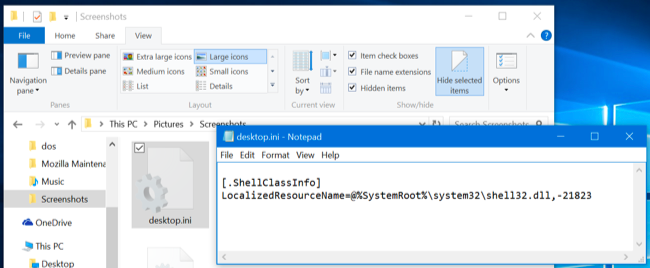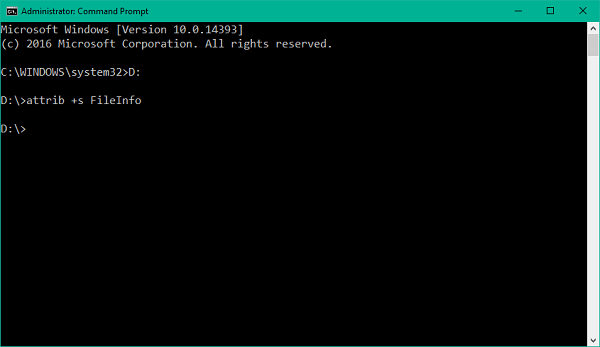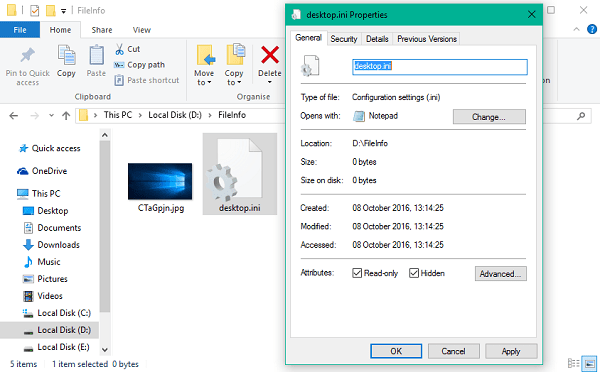Learn from AZ about Thumbs.db, Desktop.ini and .DS_Store files
Sometimes files you download from the Internet or files on your computer have files with names such as "thumbs.db" , "desktop.ini" or ".DS_Store" , you don't know if it's a file believe what. And most of us won't see these files because Windows or Mac OS X by default set up so you don't see hidden files or system files.
If you are worried that these files are not viruses or are they harmful to your laptop or computer? In the following article, the network administrator will give you some useful information about these files.
1. What is Thumbs.db file?
The "thumbs.db" file is a special file for storing thumbnails for small images in the directory. Whenever you open a folder containing images in Windows Explorer or File Explorer, Windows will create thumbnails of those images and store them.
Saving these thumbnails helps speed up the viewing of files the next time we go to the folder to view the images, instead of having to recreate the thumbnail again.
This is completely normal, and since this is a hidden file, you usually don't see them. However, in some cases these files may cause some problems. If you want to upload your image folders directly to the Web server, these files will also come along during data compression.

To prevent Windows from creating thumbs.db files - you can use Group Policy Editor (on Windows Professional or Enterprise versions) or Registry Editor (on Windows Homes version).
For Windows Professional or Enterprise versions:
To change the settings in Group Policy , press the Windows + R key combination to open the Run dialog box, then enter "gpedit.msc" into the Run dialog box and press Enter.
On the Local Group Policy window, navigate to the key:
With Windows 10, 8.1, 8:
User Configuration> Administrative Templates> Windows Components> File Explorer
With Windows 7:
User Configuration> Administrative Templates> Windows Components> Windows Explorer
Here you double-click "Turn off the caching of thumbnails in hidden thumbs.db files" and select "Enabled" .

Windows Home version:
First press the Windows + R key combination to open the Run command window , then type Regedit and press Enter to open the Registry Editor editor.
On the Registry Editor window, navigate to the key:
HKEY_CURRENT_USER Software Microsoft Windows CurrentVersion Explorer Advanced
Here find and double-click "DisableThumbnailCache" in the right window and enter the value "1" .
If you don't see DisableThumbnailCache , right-click on the right window and create a new DWORD, name this DWORD DisableThumbnailCache and set the value to " 1".
If you want to return to the initial default state, you can delete the value or set the value to "0".

2. Desktop.ini file
What is Desktop.ini file?
Windows also creates desktop.ini files. Desktop.ini is not only hidden files but also system files. You cannot see desktop.ini files if you don't have hidden items displayed and leave the Hide File System (Hide Protected Operating System Files) option in the Folder Option dialog box.
Windows uses desktop.ini files to determine how folders are displayed. For example, if you want to move some folders in Windows, Windows will notify you that the folder is a system folder and prevent you from moving that folder.
Some folders have icons (icons) set by the user or have their own background image, this information is also in the desktop.ini file .

Up to this point, there is no option to prevent Windows from creating these files. If you don't like them, the best way is to choose not to show hidden files and system files. You can also delete these files but Windows can re-create them.
2.2. Desktop.ini is a virus?

Desktop.ini file system is not a virus. It is just a native file on the system and is stored at the folder level, these files are created when you customize background wallpapers, icons or thumbnail images, etc.
Historically, however, Trojan viruses have "linked" and attacked the system under Desktop.ini. If the Desktop.ini file can be 'seen' even if you have checked the options to hide system files, it is probably malware (malware).
Therefore, to ensure the system you should use antivirus programs to eliminate the root and avoid virus attacks.
2.3. Can I delete the desktop.ini file?
You can also delete desktop.ini files, but the folder display settings will be restored to their default state. It can be understood that whenever you change the folder icon or thumbnail image, shared properties, . all this information will be automatically stored on the desktop.ini file.
And when you delete this file, your device changes will be lost, and these folder settings will be converted to the default state on the system.
After you delete it, it will automatically re-create the next time you customize the folder settings.
2.4. How to use the desktop.ini file to customize the directory?
Customizing folders using the desktop.ini file is not too difficult. You only need to create / update the original desktop.ini file for the folder to update the view and the external settings. Here are some notes you should pay attention to:
- Assign a custom icon or thumbnail image to the parent folder.
- Create an information tip that provides information about folders when you move the mouse pointer over folders.
- Customize how folders are shared or accessed.
Follow these steps to change the style of any folder using the desktop.ini file:
1. Select any folder you want to customize using the desktop.ini file. Make sure you have a backup copy of the files in a different location and can restore them in case any problems occur.

2. Run the command below to select the directory on the directory system. This will set the read only mode for the directory and enable special behavior for the desktop.ini file:
attrib + s directory name
3. Create the desktop.ini file for the folder on the question. Create hidden system files to restrict other users from being able to access them. You can do this by activating Read-only and Hiddens on the Properties window of the desktop.ini file.

Note: The desktop.ini file you created must be in the Unicode file format so that the language is stored in a readable form.
4. Below is an example of the desktop.ini file created for the folder named FileInfo:
[.ShellClassInfo]
ConfirmFileOp = 0
IconFile = ms.ico
IconIndex = 0
InfoTip = Microsoft Wallpapers

Inside:
[.ShellClassInfo] - Initializing system properties allows you to customize directories by assigning values to some properties that can be 'defined' in the desktop.ini file.
ConfirmFileOp - Set this value to 0, and you will not receive the You Are Deleting a System Folder warning when deleting or moving the desktop.ini file.
IconFile - If you want to set a custom icon for the folder, you can specify the icon file name here. To be sure you should check the full path of the file.
IconIndex - If you set a custom icon for basic folders, just set it here. Set the value to 0 if there is only one file icon in the file specified for the IconFile attribute.
InfoTip - This special attribute is used to set up a text string that can be used as a folder information tip. If you set this section into a text string and then hover your mouse over the folders, the text strings stored in the desktop.ini file will be displayed there.
3. What is the .DS_Store file?
Mac OS X operating system also creates .DS_Store files. These files are created in each folder and operate similarly to desktop.ini files on Windows.
By default, on Mac OS X, the .DS_Store file is also hidden and the file is also hidden on other Unix operating systems. You cannot see these files on Mac unless you enable hidden file viewing.
The .DS_Store file contains information about the location of a folder's icons, folder background images, and other details. When you open a folder in Finder, Finder reads this file to determine how to display the contents of the folder. When you change these settings, Finder changes the .DS_Store file settings.

The Mac also creates .DS_Store files even on folders that you share on the network, which can cause a lot of confusion, which can be confusing for Windows users.
To prevent Mac OS X operating system from creating .DS_Store files (but only on Network Drives):
First open a Terminal window by pressing Ctrl + Space , then enter "Terminal" and then press Enter or go to Applications> Utilities> Terminal.
Next enter the following command into the Terminal window and press Enter:
defaults write com.apple.desktopservices DSDontWriteNetworkStores true
If you do not want to change and let Mac OS X continue to create .DS_Store files on Network Drives, use the following command:
defaults write com.apple.desktopservices DSDontWriteNetworkStores false
Until now, there is no way to prevent Mac OS X operating system from creating .DS_Store files. However, you can hide these files in the Finder.

Refer to some of the following articles:
-
What are the thumb.db files?
-
Fix broken files
-
The tips should know with PDF files on Google Drive
Good luck!
 Your computer requires entering a password after starting from Sleep mode, this is a fix
Your computer requires entering a password after starting from Sleep mode, this is a fix Instructions for quick fix of 'Inaccessible Boot Device' error on Windows 10/8/7 and Windows Vista
Instructions for quick fix of 'Inaccessible Boot Device' error on Windows 10/8/7 and Windows Vista Summary of some simple ways to Reset Windows 10
Summary of some simple ways to Reset Windows 10 Trick to remove the default application on Windows 10
Trick to remove the default application on Windows 10 How to change the primary email address for a Microsoft account
How to change the primary email address for a Microsoft account Enable / disable ReFS (Resilient File System) on Windows 10
Enable / disable ReFS (Resilient File System) on Windows 10